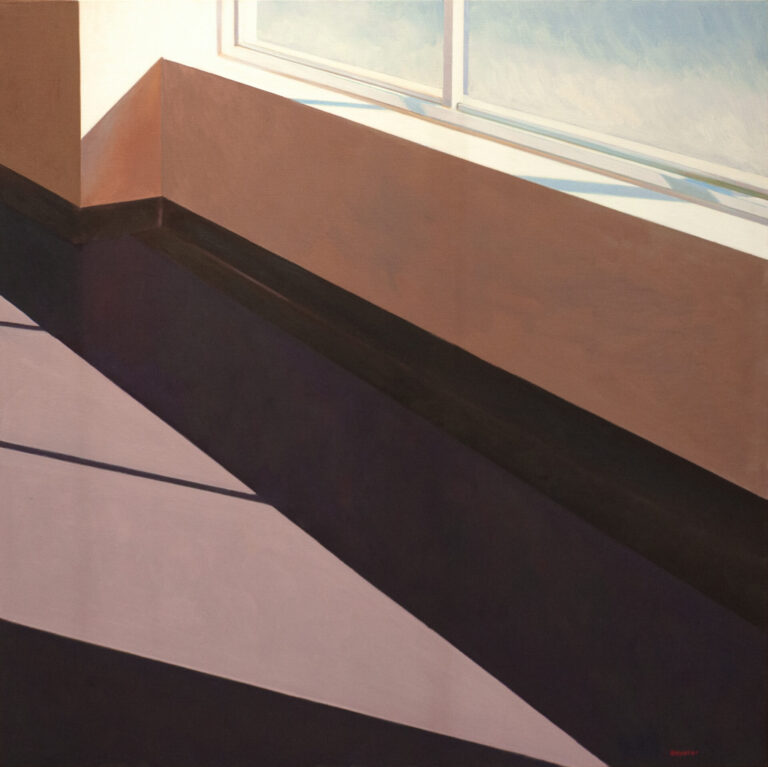John REGISTER: The Long View
Sep 21 — Oct 28, 2023
One afternoon in 1986, John Register made a sketch of a man waiting for lunch in a restaurant on the Pacific Coast Highway. There was nothing exceptional about the man, and the restaurant was typical of midcentury Southern California eateries. But the manner in which the diner rested his chin in his hand while gazing out the window reminded Register of Auguste Rodin’s Thinker. The sketch was done in just a few moments, jotted swiftly enough to capture the essence of the scene before the man’s order arrived. The painting that Register completed in the following year is as timeless as Rodin’s sculpture.
What makes Man Seated in Restaurant such a fine canvas, beyond the masterful composition and the artist’s commanding sense of color, is Register’s ability to transform an everyday scene into a philosophical treatise, compelling the viewer not only to look but also to think. Throughout his 23-year career – tragically cut short by illness and death in 1996 at the age of 57 – Register accomplished this feat by approaching the artistic tradition of realism with a keen intellect and firm moral conviction. “A realist today must deal with the threat of the bomb, extraordinary materialist and Philistine values, a hypocritical government, and a generally vulgar environment” he wrote in 1989. “Consequently, the subject matter of a realist painter must capture the feeling of isolation, the tension of nothing happening. The suspended animation. The frozenness one feels when confronted with this environment.”
Modernism is pleased to present The Long View, a major retrospective of John Register’s paintings, prints and drawings, many of which were first shown at Modernism while the artist was alive. The artworks represent nearly the entirety of his career, showing his artistic development and the consistency of his vision, as well as the versatility with which he treated favorite locations and subjects.
Although Register was born in New York City and had a successful advertising career on Madison Avenue before studying at the Art Students League, his artistic focus was on Los Angeles and the Southwest from the outset. He imbued these places with the iconic quality of movie stills, sometimes evoking the mood of stories by Raymond Chandler or John Fante (it’s no coincidence that he illustrated the Black Sparrow Press edition of Ask the Dust).
In his chosen locations, Register sought “places where real life has taken place,” such as the lobby depicted in Hotel with Four Chairs (1974), explaining to his biographer Barnaby Conrad III that “they are something we experience universally, a sort of common denominator of interior space.” He also preferred unexceptional furnishings, as can be seen in paintings such as Yellow Chair (1976). “It’s not that the ordinary chair is beautiful,” he observed, “but that in its ordinariness it becomes the essence of a chair.”
In contrast to Man Seated in Restaurant, most of these spaces are unoccupied, inviting the viewer into the picture. It’s one of the signal differences between Register and the artist he’s most often been compared with, Edward Hopper. “With Hopper, you witness someone else’s isolation,” he explained to Conrad in John Register (Chronicle Books, 1989). “In my pictures the viewer becomes the isolated one.”
Register has also often been incorrectly associated with 1970s photorealists such as Ralph Goings and Richard Estes. In common with these artists, he often used photography as the starting point for a painting, carrying a camera in his pocket wherever he went. But the photograph was never his subject, as was the case with Photorealist contemporaries. His work has at least as much in common with early 20th century Precisionists such as Charles Sheeler and even mid-century hard-edge abstractionists such as Ellsworth Kelly, and of course Richard Diebenkorn. As Register explained, “rendering from a photograph in a photo-realist manner would be so boring. For me painting is less rendering and more distillation. I try to reduce an image to its essence.”
To achieve this distillation might take months or years of constant effort. Compositionally unnecessary details were removed, reflecting Register’s conviction that “every realist painting has to be judged on its abstract merits.” Equally important, colors were reworked to evoke emotions, enhancing and exploring the sense of isolation, an existential condition he felt more acutely in the final decade-and-a-half of his life, as he faced kidney failure and cancer.
The results are perhaps most clearly evident in Waiting Room for the Beyond, a 1983 canvas that he turned into a silkscreen in 1988. An unexceptional chair is set in an empty room suffused with light, clouds visible through the window behind it. The chair is empty, facing the viewer, beckoning.
In his preface to John Register: Persistent Observer, the catalogue for a major 1998 retrospective at the San Jose Museum of Art, the legendary art historian Peter Selz astutely observed that Register’s work “went far beyond the self-imposed limitations of realism to reach for the spiritual.” Through his distinctive combination of observation and invention, Register made the spiritual realm as real as a diner or hotel lobby.
FOR FURTHER INFORMATION CALL: 415-541-0461
OR EMAIL: INFO@MODERNISMINC.COM
Check gallery website for hours and additional info
